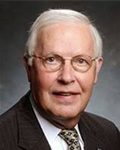 It is with profound sadness that we announce the passing of J. Max Austin, Jr., M.D., a revered figure in the field of gynecologic oncology and a cherished member of the UAB Department of Obstetrics and Gynecology. Dr. Austin passed away on Wednesday, August 14, 2024, leaving behind a legacy of dedication, compassion, and excellence that will continue to inspire future generations of medical professionals.
It is with profound sadness that we announce the passing of J. Max Austin, Jr., M.D., a revered figure in the field of gynecologic oncology and a cherished member of the UAB Department of Obstetrics and Gynecology. Dr. Austin passed away on Wednesday, August 14, 2024, leaving behind a legacy of dedication, compassion, and excellence that will continue to inspire future generations of medical professionals.-
Professional Milestones
Professional Milestones
1963 | Dr. Austin graduates from Emory University.
1967 | Dr. Austin receives a Doctor of Medicine from the University of Alabama (UAB).
1971 | Dr. Austin becomes chief resident at the School of Medicine at UAB.
1971 | Dr. Austin serves as major and as Chief of Obstetrics and Gynecology at Homestead Air Force Base in Florida.
1973 | Dr. Austin becomes a fellow in gynecologic oncology at UAB.
2000 | Dr. Austin closes his private practice after 23 years to become a full-time professor in the Division of Gynecologic Oncology at UAB.
2000 | The J. Max Austin Jr. Professorship of Gynecologic Oncology is established in the Department of Obstetrics and Gynecology at the University of Alabama at Birmingham, with Dr. Austin being its first recipient.
2002 | Dr. Austin becomes President of Society of Gynecologic Oncology (SGO)
2005 | Dr. Austin is nominated by the Argus Committee (Medical Students) for best faculty teacher in the Department of Obstetrics and Gynecology at the UAB School of Medicine. He receives a nomination for two more years, and is selected in 2007.
2006 | Dr. Austin is selected by the Birmingham Business Journal as a “Health Care Hero, Physician, and Provider.”
2008 | Dr. Austin is selected by the Oxford College of Emory University of Board of Counselors for the Carl Chandler Alumnus Award, the highest alumnus award from Oxford College.
2009 | Dr. Austin is nominated and selected for the Lifetime Achievement Award by the Elmore County 4-H Club.
2010 | Dr. Austin is honored with an Endowed Chair in Gynecologic Oncology at UAB.
2010 | Dr. Austin receives the MASA Award and the Paul W. Burleson Award in recognition of distinguished service to county, state and national physician organizations.
2012 | Dr. Austin is selected as Significant Sig by the National Sigma Chi Fraternity, the highest award given to Sigma Chi alumni.
2015 | Dr. Austin is selected as Significant Sig by the National Sigma Chi Fraternity, the highest award given to Sigma Chi alumni.
2019 | Dr. Austin receives the Distinguished Alumnus Award from the Medical Alumni Association of the UAB Medical Center.
-
Scholarly Works
Scholarly Works
- A phase II trial of weekly topotecan for patients with secondary platinum-resistant recurrent epithelial ovarian carcinoma following the failure of second-line therapy
- SGO presidential address February 3, 2003
- Stage IC adenocarcinoma of the endometrium: Survival comparisons of surgically staged patients with and without adjuvant radiation therapy
- A phase I study of combined modality intraperitoneal radioimmunotherapy for ovarian cancer
- Conservative management of Stage I endometrial carcinoma after surgical staging
- Intraperitoneal radioimmunochemotherapy of ovarian cancer: A phase I study
- The society of gynecologic oncologists outcomes task force. Study of endometrial cancer: Initial experiences
- Surgical management of endometrial adenocarcinoma using laparoscopically assisted staging and treatment
- Response to salvage treatment in recurrent ovarian cancer treated initially with paclitaxel and platinum-based combination regimens
- Treatment of the small unruptured ectopic pregnancy: A cost analysis of methotrexate versus laparoscopy
- Adenocarcinoma of the endometrium: Survival comparisons of patients with and without pelvic node sampling
- T2/3 vulva cancer: A case-control study of triple incision versus en bloc radical vulvectomy and inguinal lymphadenectomy
A matched comparison of single and triple incision techniques for the surgical treatment of carcinoma of the vulva - Staging ovarian cancer diagnosed during laparoscopy: Accuracy rather than immediacy
- The groshong catheter as an intraperitoneal access device in the treatment of ovarian cancer patients
- The validity and significance of substages of advanced ovarian cancer
- A matched comparison of single and triple incision techniques for the surgical treatment of carcinoma of the vulva
- Effect of deoxyribonucleic acid ploidy status on survival of patients with carcinoma of the endometrium
- Second-look laparotomy and salvage therapy: A research modality only?
- Primary surgical therapy of ovarian cancer: How much and when
- Intraperitoneal chromic phosphate in ovarian cancer: Risks and benefits
- Ureteral strictures and fistulae following radical hysterectomy
Cervical choriocarcinoma associated with an intrauterine contraceptive device: A case report- Hemodynamic parameters following pelvic exenteration
- Urinary diversion in patients undergoing pelvic exenteration
- Verrucous lesions of the female genitalia. I. Giant condylomata
- Verrucous lesions of the female genitalia. II. Verrucous carcinoma
- Trophoblastic disease in Alabama.
- Acute pulmonary edema associated with molar pregnancies: A high-risk factor for development of persistent trophoblastic disease
- Is pelvic radiation beneficial in the postoperative management of stage Ib squamous cell carcinoma of the cervix with pelvic node metastasis treated by radical hysterectomy and pelvic lymphadenectomy? A report from the presidential panel at the 1979 Annual Meeting of the Society of Gynecologic Oncologists
- Colposcopy or cervical conization? An economic comparison
- Folate-induced regression of cervical dysplasia in users of oral contraceptive agents (OCA)
- What the gynecologist expects from the pathology report.
- The significance of age in the colposcopic evaluation of women with atypical papanicolaou smears
- Outpatient evaluation of patients with atypical Papanicolaou smears: Contribution of endocervical curettage
- A classification of endocervical curettings
- 'The abnormal Pap smear' and its evaluation. The modern approach
- The contribution of endocervical smears to cervical cancer detection